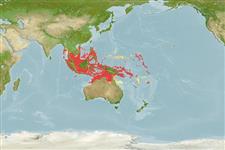>
Scombriformes (Mackerels) >
Scombridae (Mackerels, tunas, bonitos) > Scombrinae
Etymology: Rastrelliger: Latin, rastra = rake + Latin, gero = to carry.
More on author: Bleeker.
Environment: milieu / climate zone / depth range / distribution range
Ekologi
laut; payau; oceanodromus (Ref. 51243); kisaran kedalaman 15 - 200 m (Ref. 28016). Tropical; 20°C - 30°C (Ref. 54858); 18°N - 18°S, 93°E - 180°E (Ref. 54858)
Pacific Ocean: Andaman Sea to Thailand, Indonesia, Papua New Guinea, Philippines, Solomon Islands and Fiji.
Length at first maturity / Size / Weight / umur
Maturity: Lm 17.3 range ? - ? cm
Max length : 34.5 cm FL jantan/; (Ref. 168); common length : 20.0 cm FL jantan/; (Ref. 168); Umur maksimum dilaporkan: 2.00 Tahun (Ref. 796)
Duri punggung (Keseluruhan (total)) : 8 - 11; duri punggung lunak (Keseluruhan (total)) : 12; Duri dubur: 0; Sirip dubur lunak: 12; vertebrata, bertulang belakang: 31. This species is distinguished by the following characters: body very deep, its depth at posterior margin of opercle 3.7-4.3 times in fork length; head equal to or less than body depth; maxilla covered by lacrimal bone but extending nearly to end of lacrimal; gill rakers very long, visible when mouth is opened, 30-48 on lower limb of first gill arch; numerous bristles on longest gill raker, about 150 on one side in specimens of 12.7 cm, 210 in specimens of 16 cm, and 240 at 19 cm fork length; intestine very long, 3.2-3.6 times fork length; snout pointed; swim bladder present; vertebrae 13 + 18 = 31; interpelvic process small and single; anal spine rudimentary. Colour of spinous dorsal fin yellowish with a black edge, pectoral and pelvic fins dusky, other fins yellowish (Ref. 168, 9684).
An epipelagic, neritic species that tolerates slightly reduced salinities in estuarine habitats and in areas where surface temperature range between 20° and 30°C. It forms schools of equally sized individuals. Batch spawning is believed to extend from March through September. Feeds chiefly on microzooplankton with a high phytoplankton component. Marketed fresh, frozen, canned, dried salted and smoked (Ref. 168, 9684).
Collette, B.B. and C.E. Nauen, 1983. FAO Species Catalogue. Vol. 2. Scombrids of the world. An annotated and illustrated catalogue of tunas, mackerels, bonitos and related species known to date. Rome: FAO. FAO Fish. Synop. 125(2):137 p. (Ref. 168)
Status IUCN Red List (Ref. 130435: Version 2024-1)
ancaman kepada manusia
Harmless
penggunaan manusia
Perikanan: bernilai komersial tinggi; Ikan buruan: ya
Alat, peralatan
laporan khas
muat turun XML
Sumber internet
Estimates based on models
Preferred temperature (Ref.
123201): 23.3 - 28.4, mean 27.2 °C (based on 781 cells).
Phylogenetic diversity index (Ref.
82804): PD
50 = 0.6250 [Uniqueness, from 0.5 = low to 2.0 = high].
Bayesian length-weight: a=0.00955 (0.00816 - 0.01117), b=3.06 (3.02 - 3.10), in cm total length, based on LWR estimates for this species (Ref.
93245).
Trophic level (Ref.
69278): 2.7 ±0.31 se; based on food items.
Generation time: 0.9 (0.8 - 1.1) years. Estimated as median ln(3)/K based on 38
growth studies.
Daya lenting (Ref.
120179): Tinggi, Waktu penggandaan populasi minimum kurang dari 15 bulan (K=0.6-1.6; tmax=2).
Prior r = 1.19, 95% CL = 0.79 - 1.79, Based on 3 data-limited stock assessments.
Fishing Vulnerability (Ref.
59153): Low vulnerability (18 of 100).
Climate Vulnerability (Ref.
125649): High to very high vulnerability (69 of 100).
Nutrients (Ref.
124155): Calcium = 241 [85, 719] mg/100g; Iron = 3.44 [1.55, 7.60] mg/100g; Protein = 20.8 [19.5, 22.1] %; Omega3 = 0.366 [0.161, 0.855] g/100g; Selenium = 66.4 [19.0, 217.7] μg/100g; VitaminA = 10.8 [2.1, 48.4] μg/100g; Zinc = 1.95 [1.04, 5.00] mg/100g (wet weight); based on
nutrient studies.
